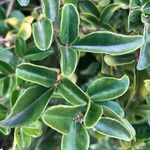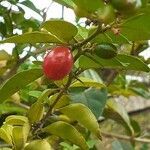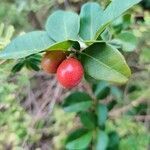A small spiny shrub up to 7 m high with slender zigzag twigs. There are 2 spines near each leaf. The leaves have 3 leaflets and are small and dark green with slightly toothed edges. Flowers are in axils of leaves and are white and about 1 cm across. The small berry is green when young and turns red when ripe. They are 1-2 cm across. The skin has glands in it and the 3 sections of the fruit have 1-3 slimy seeds inside.
Erect shrub, with paired axillary thorns 5–17 mm. long, pubescent, later glabrescent.. Leaves trifoliolate; leaflets ovate-rhombic, 1.5–4.5 cm. long, emarginate, slightly crenate.. Flowers 1–several in the axils, 3-merous.. Berries ellipsoid-globose, 12–16 mm. in diameter, orange-red.



